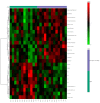The Urinary Metabolome of Newborns with Perinatal Complications
- PMID: 38248844
- PMCID: PMC10819924
- DOI: 10.3390/metabo14010041
The Urinary Metabolome of Newborns with Perinatal Complications
Abstract
Maternal pathological conditions such as infections and chronic diseases, along with unexpected events during labor, can lead to life-threatening perinatal outcomes. These outcomes can have irreversible consequences throughout an individual's entire life. Urinary metabolomics can provide valuable insights into early physiological adaptations in healthy newborns, as well as metabolic disturbances in premature infants or infants with birth complications. In the present study, we measured 180 metabolites and metabolite ratios in the urine of 13 healthy (hospital-discharged) and 38 critically ill newborns (admitted to the neonatal intensive care unit (NICU)). We used an in-house-developed targeted tandem mass spectrometry (MS/MS)-based metabolomic assay (TMIC Mega) combining liquid chromatography (LC-MS/MS) and flow injection analysis (FIA-MS/MS) to quantitatively analyze up to 26 classes of compounds. Average urinary concentrations (and ranges) for 167 different metabolites from 38 critically ill NICU newborns during their first 24 h of life were determined. Similar sets of urinary values were determined for the 13 healthy newborns. These reference data have been uploaded to the Human Metabolome Database. Urinary concentrations and ranges of 37 metabolites are reported for the first time for newborns. Significant differences were found in the urinary levels of 44 metabolites between healthy newborns and those admitted at the NICU. Metabolites such as acylcarnitines, amino acids and derivatives, biogenic amines, sugars, and organic acids are dysregulated in newborns with bronchopulmonary dysplasia (BPD), asphyxia, or newborns exposed to SARS-CoV-2 during the intrauterine period. Urine can serve as a valuable source of information for understanding metabolic alterations associated with life-threatening perinatal outcomes.
Keywords: LC-MS/MS; NICU; asphyxia; bronchopulmonary dysplasia; metabolites; metabolomics; newborns.
Conflict of interest statement
The authors declare no conflicts of interest.
Figures



Similar articles
-
Urinary metabolomics of bronchopulmonary dysplasia (BPD): preliminary data at birth suggest it is a congenital disease.J Matern Fetal Neonatal Med. 2014 Oct;27 Suppl 2:39-45. doi: 10.3109/14767058.2014.955966. J Matern Fetal Neonatal Med. 2014. PMID: 25284176
-
Urinary Metabolomic Profile of Neonates Born to Women with Gestational Diabetes Mellitus.Metabolites. 2021 Oct 22;11(11):723. doi: 10.3390/metabo11110723. Metabolites. 2021. PMID: 34822382 Free PMC article.
-
Profiling of urinary amino-carboxylic metabolites by in-situ heptafluorobutyl chloroformate mediated sample preparation and gas chromatography-mass spectrometry.J Chromatogr A. 2016 Apr 22;1443:211-32. doi: 10.1016/j.chroma.2016.03.019. Epub 2016 Mar 10. J Chromatogr A. 2016. PMID: 27012787
-
Metabolomics in Newborns.Adv Clin Chem. 2016;74:35-61. doi: 10.1016/bs.acc.2015.12.006. Epub 2016 Jan 19. Adv Clin Chem. 2016. PMID: 27117660 Review.
-
Mass spectrometric based approaches in urine metabolomics and biomarker discovery.Mass Spectrom Rev. 2017 Mar;36(2):115-134. doi: 10.1002/mas.21455. Epub 2015 Apr 16. Mass Spectrom Rev. 2017. PMID: 25881008 Review.
Cited by
-
Analysis of variable metabolites in preterm infants with bronchopulmonary dysplasia: a systematic review and meta-analysis.Ital J Pediatr. 2024 Nov 14;50(1):246. doi: 10.1186/s13052-024-01812-9. Ital J Pediatr. 2024. PMID: 39543750 Free PMC article.
-
Olaris Global Panel (OGP): A Highly Accurate and Reproducible Triple Quadrupole Mass Spectrometry-Based Metabolomics Method for Clinical Biomarker Discovery.Metabolites. 2024 May 11;14(5):280. doi: 10.3390/metabo14050280. Metabolites. 2024. PMID: 38786757 Free PMC article.
-
Challenges and recent advances in quantitative mass spectrometry-based metabolomics.Anal Sci Adv. 2024 Jun 26;5(5-6):e2400007. doi: 10.1002/ansa.202400007. eCollection 2024 Jun. Anal Sci Adv. 2024. PMID: 38948317 Free PMC article. Review.
References
-
- World Health Organization . Newborn Mortality. World Health Organization; Geneva, Switzerland: 2022.
-
- Joseph Pellissery A., Gopika Vinayamohan P., Susan Viju L., Joseph D., Venkitanarayanan K. Advances and Challenges in Urine Laboratory Analysis [Working Title] IntechOpen; Rijeka, Croatia: 2023. Application of Urine Metabolomics as a Marker in Health and Disease.
Grants and funding
LinkOut - more resources
Full Text Sources
Miscellaneous

